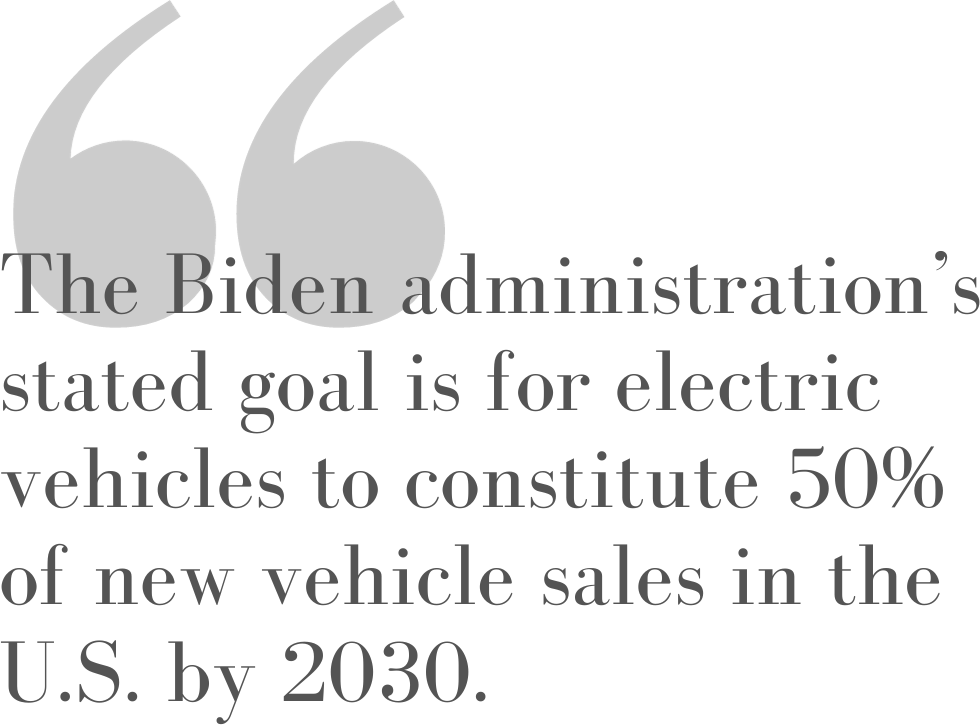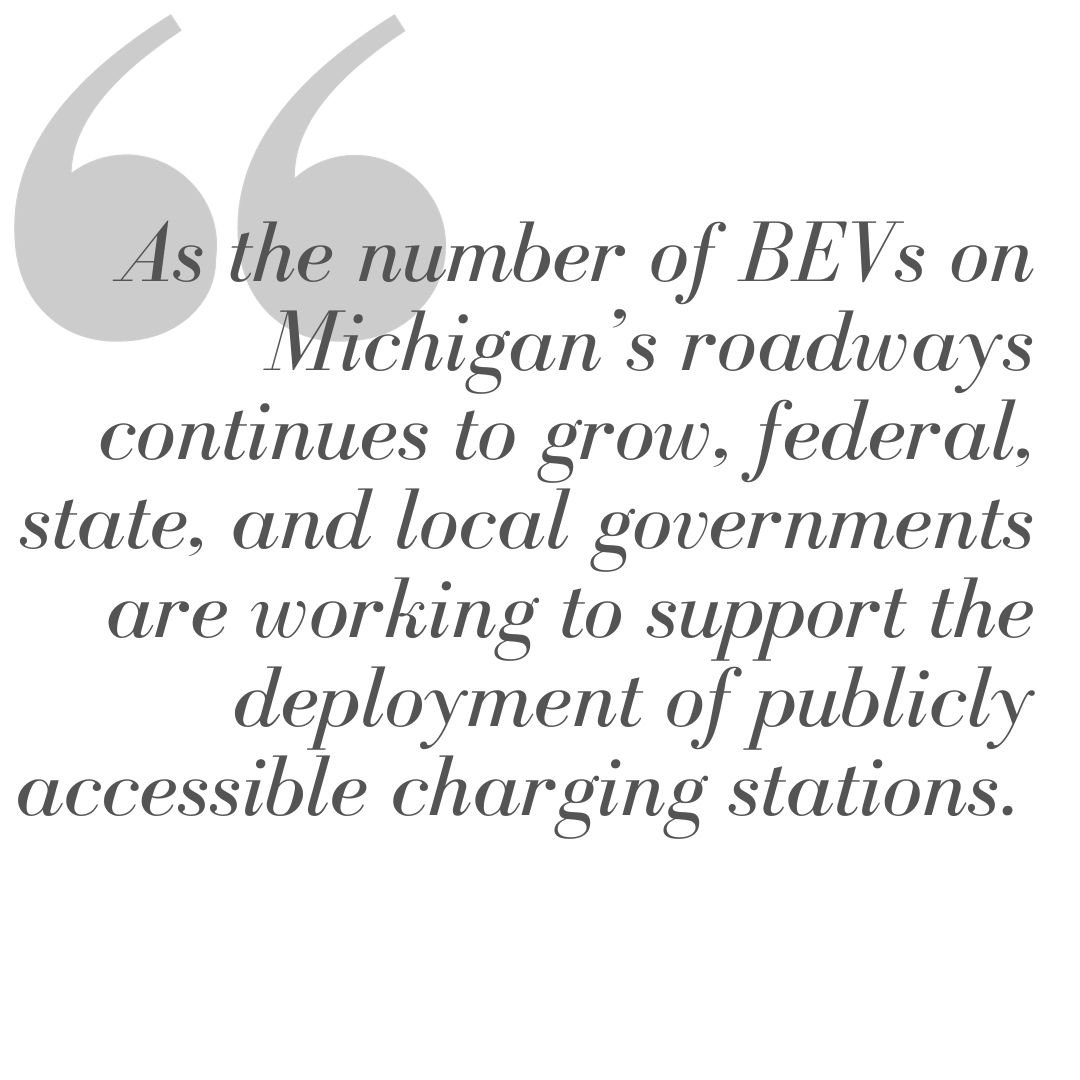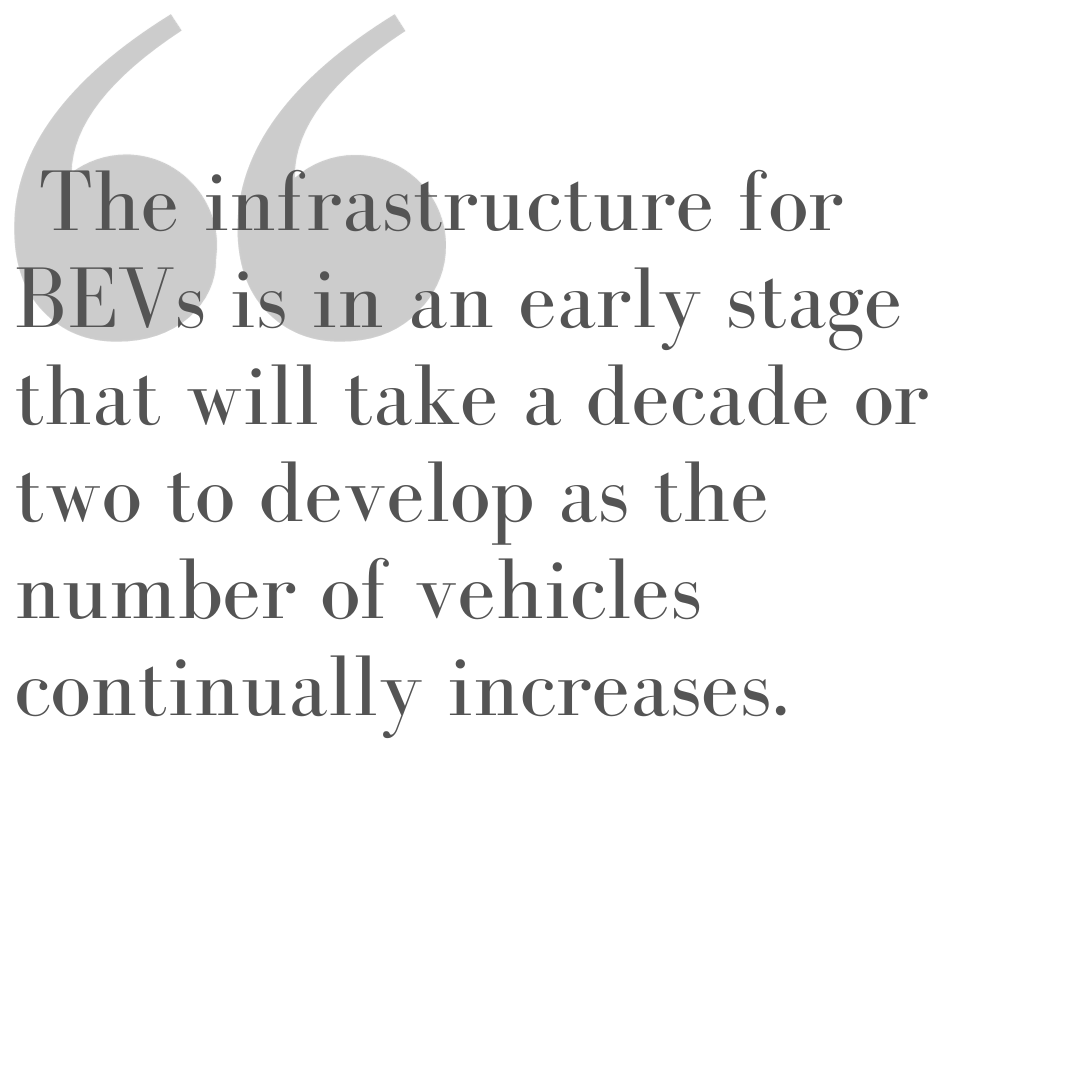Plugged In: An EV Newsletter Vol. 1 No. 8
DOWNLOAD PDF- Weiss, Robert
- Industry Alerts
Click “Subscribe Now” to get attorney insights on the latest developments in a range of services and industries.
Introduction
The focus of this issue of Plugged In is the critical role played by all levels of government in the rapid transition from ICE to BEV.
Our first article is entitled “Government’s Critical Role in Transition to EVs - An Overview." Although media focus has been on the federal government’s initiatives and funding, state, regional and local governments are playing critical roles by virtue of their respective EV related legislation, regulations and in connection with their administering federal funding.
We are privileged to share with you in this edition the insights of the office of Oakland County Economic Development, which, in collaboration with regional and local governments, is playing such an important role in facilitating this transition in Southeast Michigan. I think you will find the article authored by Chris Olzem, Mobility Innovations Coordinator, Oakland County Government, entitled “Planning and Funding Options for EV Charging Stations in Oakland County” very informative.
Finally, please check out our recurring column “In Case You Missed It". I think you will find the articles profiled worth to read.
As always, we encourage your suggestions for topics to cover and, in general, ways we can provide more value to our readers.
Robert B. Weiss | Of Counsel and Co-Chair, EV Initiative

Government’s Critical Role in Transition to EVs - An Overview
Governments around the world have been major catalysts, if not the primary catalysts, for the on-going transformation of the automotive industry from the internal-combustion engine to the electric vehicle. Aggressive pollution-emission standards are integral to government policy to accelerate the transition to electric vehicles. The Biden administration’s stated goal is for electric vehicles to constitute 50% of new vehicle sales in the U.S. by 2030. Britain has banned gasoline and diesel vehicle sales as of 2030, and the EU has banned them as of 2035.
Government contributions and impact range from (1) new regulatory frameworks that favor the new propulsion systems; (2) funding infrastructure investments that accelerate a broader adoption of the new technologies (charging stations, for example); and (3) direct financial assistance (including loan guarantees, grants, and rebates). The scope and breadth of these contributions have been extraordinary – hundreds of billions of dollars – and are proving essential to this transformation.
In addition to aggressive, EV-friendly-emission regulations, and fuel-economy standards, the Biden administration committed hundreds of billions of dollars to facilitate and expedite the transition. The two signature-pieces of legislation to accomplish this goal are the Inflation Reduction Act (“IRA”) and the Infrastructure Investment and Jobs Act (“IIJA”) (which is also known as the Bipartisan Infrastructure Act). These Acts became effective in late 2021 and early 2022, and jointly provide $370 billion in federal funding through a combination of tax rebates, credits, loans, loan guarantees, and outright grants to expedite the transition to clean energy, with a significant portion allocated to expediting the transition to electric vehicles. The Bipartisan Infrastructure Act committed $7.5 billion to develop and construct critical, nationwide, EV-charging infrastructure to support the administration’s objective to construct 500,000 new-EV-charging stations by 2030.
To expedite consumer adoption, the federal government provides up to a $7,500 tax credit to those who purchase qualifying electric vehicles (subject to limitations based on the source of manufacturing and processing of vehicle components and the purchaser’s income). There are also tax incentives for those who purchase qualifying used EVs (again, subject to certain income limitations).
Although support at the federal level has been by far the most important, state, regional, and local governments are playing a crucial role as well. For example, it is reported that 47 states and the District of Columbia offer incentives to purchase EVs, chargers, and other related equipment. More than 1,200 of these types of bills have been introduced at the state and federal levels since 2022.
California has adopted a goal to have at least 5 million zero omissions vehicles on its roads by 2030 and only zero omission new vehicle sales in the state by 2035, a significantly more aggressive timeline than the federal government’s goal of 50% of new car sales be zero omission by 2030.
Adequate and well-located charging stations is an obvious prerequisite for accomplishing the above goals. To achieve these objectives, California has approved legislation to streamline the process of installing charging stations. For example, one piece of legislation requires local jurisdictions to approve or deny an application to install a charging station by a defined period of time and limit the basis for denial solely to a written finding "based on substantial evidence" that the installation would impact public health or safety in a manner that could not be mitigated or avoided.
Similar to the federal government, state and local governments are increasingly enacting regulations and ordinances to increase the charging infrastructure, including providing financial incentives and support. For example, in the Clean Energy in Michigan series sponsored by the University of Michigan, it is reported that the City of Ypsilanti incentivizes businesses to install charging infrastructure by instituting an ordinance reducing the requirement for off-street parking spaces if some of those spaces are fitted with chargers. Another example given is Grand Rapids, which requires parking structures to have one charging station for every 200 spaces.
Many of these state and local initiatives are funded by federal money. For example, the Bipartisan Infrastructure Act earmarks $5 billion for state-administrated grants to develop charging infrastructure. Similarly, the Discretionary Grant Program for Charging and Fueling Infrastructure, administered through the US Department of Transportation, earmarks $1 billion to develop charging infrastructure in rural and local-income neighborhoods.
As shown above, sustained government support has been, and will continue to be, essential to rapidly transition to EVs.
Robert B. Weiss | Of Counsel and Co-Chair, EV Initiative

Planning and Funding Options for EV Charging Stations in Oakland County, Michigan
Globally, passenger vehicle technologies are experiencing several major transformations to improve safety but may alter driving habits. These transformations include wireless communication between intersection infrastructure and vehicles (V2I), advanced safety systems, and alternative fuels. Oakland County plays a small but critical role in testing infrastructure to vehicle (V2I) communication and advanced safety systems. The county also dedicates substantial resources to alternative fuels and has plans to focus on strategic development and deployments in this area.
At the end of 2022, there were 33,150 registered Battery Electric Vehicles (BEV) in Michigan compared to a total of almost 8 million registered passenger vehicles. BEVs account for less than 1% of all passenger vehicles on our roadways. Another important statistic is BEVs account for 8% of new passenger vehicle sales in the United States, with this percentage increasing each year. As the number of BEVs on Michigan’s roadways continues to grow, federal, state, and local governments are working to support the deployment of publicly accessible charging stations. Due to the substantial length of time from the moment a community or company decides to install Electric Vehicle (EV) charging infrastructure, to when that system is up and running, it is imperative that deployment planning begins now, to ensure an adequate number of chargers are available for the increase of BEVs in the coming years.
The average vehicle in Michigan is driven 12,120 miles each year. Michigan BEVs are charged at a personal residence 80% of the time and 97% of miles driven takes place less than 50 miles from home. But virtually everyone drives more than 50 miles before arriving back home many times each year. For some, this is a daily or weekly occurrence based on their work commute or other regularly driven routes. Also, government planners recognize a significant portion of the population live in apartments and condominiums which are less likely to have garages or primary residences that do not have garages with adequate electrical service to charge a BEV.
Oakland County is in the process of deploying a combination of Level 2 and DC fast chargers on its campus along Telegraph Road and in several Oakland Count Parks. While the County will own this first batch of chargers, not all future charger deployments will necessarily be County owned and operated. The initial wave of installations is primarily funded by State and Federal government grants. The State of Michigan provided a $1 million grant which did not require any matching funds. Oakland County has applied for a $3.5 million Charging and Fueling Infrastructure grant which awardees are expected to be announced in late 2023 or early 2024.

The Charging and Fueling Infrastructure Grant is funded by the U.S. Department of Transportation and provides 80% of the cost of a project and requires a 20% match from the applicant. Applicants can be state and local governments, federally recognized tribes, transportation providers or operators, and U.S. territories. In order to have a network of EV chargers in good working order, the grant requires the charger to be operational 97% of the time. The grant can also include the cost of minor grid updates such as power meter, transformer, and switch gear. The chargers must also be publicly accessible, so any barrier such as a fenced off parking lot cannot use these federal dollars for these projects.
There are many stories of frustrated BEV drivers arriving at an out of service charging station. While Oakland County will own the chargers located on county property at least for this first deployment, it does not have the technical expertise to maintain the units. It is common for the charger manufacturer to provide a multi-year warranty for hardware and software (up to ten years for one manufacturer). There are also companies that can service the charging unit after the warranty period and there are charger insurance options as well.
The infrastructure to support internal combustion engines took decades to develop and refine and were reimagined multiple times. The infrastructure for BEVs is in an early stage that will take a decade or two to develop as the number of vehicles continually increases.
Though the process to install electric vehicle chargers is long, especially when it is a community’s first deployment, it is necessary. Communities in Metro Detroit are actively sharing their best practices and knowledge is gained at each stage of the process and efficiencies will be learned. With investment in the tens of billions of dollars from domestic OEMs and their supply chain to convert passenger vehicles to electric power from internal combustion engines, it is the goal of Oakland County to support this transition.
Chris Olzem | Mobility Innovations Coordinator, Oakland County Government
In Case You Missed It
In this edition of “In Case You Missed It,” we provide commentary and links to several interesting articles providing different perspectives regarding the challenges and opportunities associated with the rapid transition to EVs.
"Toyota Chasing Tesla and what it says about the UAW" - Automotive News
Perhaps the two hottest topics in the auto industry today are the rapid transition to EVs and the UAW strike. Jamie Butters, Executive Editor of Automotive News, addresses the interrelationship of these two subjects in his recent article entitled "Toyota Chasing Tesla and what it says about the UAW”.
"Rapid Proliferation of EV Charging Stations on Commercial Properties Create Real Estate Questions"

My colleague, Katheryne Zelenock's article from the September edition of Plugged In complements Chris Olzem’s article above. In case you missed it, the link is above.
“America’s Loneliest Road is Finally EV-Ready”
Staying on the subject of charging infrastructure, we note an interesting article in Bloomberg Green entitled “America’s Loneliest Road is Finally EV-Ready”, which discusses the proliferation of charging stations in rural areas, including Route 50, the “Loneliest Road” referenced in the title.
"Automakers Have Big Hopes for EVs; Buyers Aren’t Cooperating"
In this article, appearing in the October 15th edition of the Wall Street Journal, the author discusses the slowdown in EV sales in the US and questions “…whether the industry is confronting a short term blip or a more protracted challenge."
Robert B. Weiss | Of Counsel
Related Practices
Recent Insights
- Industry Alerts Plugged In: An EV Newsletter - Vol. 1, No. 3
- Industry Alerts Will Washington’s Decoupling Agenda Delay the EV Transition | 华盛顿的战略脱钩计划会延缓电气化的转型吗?
- Articles Canada’s Long-Awaited Artists’ Resale Right: What’s Changing and Why It Matters
- May 19, 2025 Industry Alerts Plugged In: An EV Newsletter Vol. 3, No. 5
- April 17, 2025 Industry Alerts Plugged In An EV Newsletter Vol. 3, No. 4
- March 17, 2025 Industry Alerts Plugged In: An EV Newsletter Vol. 3, No. 3
- February 17, 2025 Industry Alerts Plugged In: An EV Newsletter Vol. 3, No. 2
- January 13, 2025 Industry Alerts EV Newsletter Vol. 3, No. 1
- December 16, 2024 Industry Alerts Plugged In: An EV Newsletter Vol. 2, No. 10

